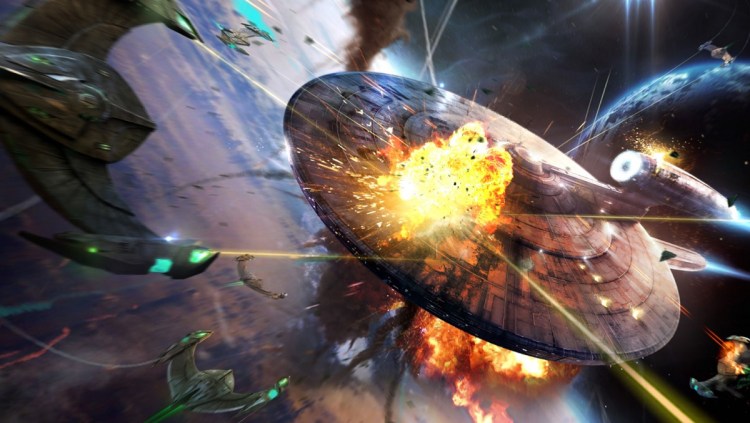GamesBeat: We’re in our free-for-all phase now if anybody wants to dive in or contribute. Do you have any observations about China as well, and whether you would–
Audience: Talking about secondary markets, about 10 years ago there was a secondary market called TXL, around the old generation of PC MMO games like World of Warcraft and EVE Online. But now, the secondary market in China is almost completely gone. They changed things a bit. A lot of companies, when they launched a big title, they hired guild members who used to play World of Warcraft and the big MMOs to get together and help the app to get on the charts. If I’m going to say any more, I’ll have to go off the record. [laughs] But there’s always a secondary market opportunity.
GamesBeat: Spencer, did any of this bring something to mind for you?
Tucker: One thing I thought about from a game economy standpoint–as these games become more like live services and have years and years of life, it’s hard to predict where a game’s going to go. If it’s around 10 years, it becomes an experiment in time and how you manage that funnel of the original game, because the game materially changes over time.
June 5th: The AI Audit in NYC
Join us next week in NYC to engage with top executive leaders, delving into strategies for auditing AI models to ensure fairness, optimal performance, and ethical compliance across diverse organizations. Secure your attendance for this exclusive invite-only event.
One thing we see a lot of in older games is, how do you preserve the entirety of the experience between the launch of the game and 10 years down the line? That funnel can be challenged in a number of ways. For instance, if you just put out new content, if you’re paying attention to the oldest, largest cohort that’s sitting at the tip of the funnel, a lot of times you can devalue the experience and devalue the content for everyone coming into the funnel the first time. That’s a challenge. It depresses the performance of the funnel. It depresses retention. It depresses your ability to monetize. Everything is depressed. It makes it harder to acquire.

Above: RockYou tried taking over old games and operating them for the long term.
GamesBeat: On that point, what I’ve seen with older games is that once they’re past peak, they start to go on this downward curve of users. They start to go to other games. That’s the time when–it’s an important decision-making time for the companies. If they try to double up the prices for the remaining players to pay, they can run into the player revolts that we’ve seen across mobile games, especially the older ones, where the players feel like they’re being squeezed, even though they’re the most loyal players. Why would anybody at the company think that they have the right to squeeze me when I’m one of the only people who’s paying for this game?
Tucker: The other downside to that, typically, is if you’re doing that, you’re also, by proxy, increasing the price for all the new people coming into the funnel. You’re saying, hey, the most valuable, the most important, the only thing you should care about is 125 levels in, and it’s priced at 4X what was originally the highest price for a piece of content when the game launched. It further damages the integrity of your funnel in that sense as well.
That’s a challenge. As we continue to think about that and see games lasting longer, there’s a lot of different approaches. One of those approaches can be to define experience within a period of time across the game. You’re effectively managing–as an example, we might say between level one and level five, level six to level 10, level 11 to level 15, the experience is being curated for that period. It’s independent from the experience, largely so it will be reflective of a lot of the same things, but it’s managed independently of that progression downstream.
An example of that might be, at level one to five, we introduce this feature. We introduce this currency. We introduce these items as the items you really want. This is the place to grind. These are the actions we expect you to perform. When you graduate to six, some of those things carry over, but the content is fresh. Maybe we take some of the other content that was desirable and make it more common in that next phase. We introduce new uncommon content. Managing the funnel in that sense, so that you’re not necessarily deprecating the value of the experience as you continue to add to the game.
GamesBeat: RockYou (rest in peace) had the business model of taking over old games and then really ratcheting up the advertising revenue as much as they could.
Tucker: That’s a path too. The challenge here is, you want these games to last as long as possible. You want to protect the integrity of that experience. People form connections, social connections, in these games. A lot of these MMO games, that’s what is stickiest about the experience.
You have to be able to scale. Where the biggest opportunity for–let’s call it points of innovation, challenging our assumptions around what we can do. The most value is always going to be at the end, that last segment. That’s the people who are pushing up against the boundaries of what exists in the game. But downstream, if you do automate that process, I actually think that’s a better path to a more stable baseline. You need that stability. You need to protect the integrity of that funnel.
Doing that allows you to do things like multivariant tests, optimizing that way, versus very ad hoc sorts of manpower-heavy, prone to accident, prone to all kinds of issue–having people iterate against a particular funnel and having to scale your workforce to some insane degree to be able to support that. That’s the challenge.
A lot of games find themselves figuring that out a bit too late. They build a game. They manage that funnel. They deprecate content. Then they find acquisition costs are going up. They find that players are–the experience they build initially has been more or less destroyed by virtue of what’s been done down the line. It becomes a challenge. What do you do in that case? But I think as we build games and start thinking of these games as lasting for a decade or more — extendible evergreen, for lack of a better term — these are the sorts of decisions that you want to get ahead of. Decisions and strategic ways of thinking you might not normally think about when you’re building a game.

Above: Little dwarf in the big city in World of Warcraft: Classic.
Linden: Or after 15 years you get to slap “Classic” on it and re-release it again. [laughter] Honestly, that’s an amazing feat. I’m still blown away by that. You take a game from 15 years ago, and it was so iconic and so ingrained in the culture that you can release it as it was 15 years later, and it’s through the roof. 15,000 people deep in these queues waiting to play.
Audience: It takes the courage to keep it that way. You need to leave it the way.
Audience: That’s the rule. If you last 15 years, you get to do it again.
Linden: That’s all you have to do. You just have to get a game to last 15 years and then you start it over.
Tucker: When we talk about game economies, we talk about–all the negative press you see is people having bad experiences with purchasing. Or the general experience, a sum of that aggregate sentiment that exists around the product. I think a lot of companies don’t necessarily think about the purchase experience as a game. I think that too is an area of opportunity for the future, when we think about–what is value? How do we deliver that value? How do we ensure the experience of engaging and monetizing is sticky, is retentive? That leads to better sentiment. It leads to all sorts of things.
There are specific examples, but–I think that’s a huge opportunity as well, regardless of what your business model is. Think about–rather than, “Oh, monetization or purchasing is just this added layer, just a way to eke money out,” it’s more like, “How do you make that experience compelling?”
I think a lot of people correlate monetization with power, selling power. I don’t think that’s a great example. There are other ways to manage the experience. Some of it’s more visual or experiential. Not necessarily cosmetic. For instance, if we think about–how do we usually treat the economy around upgrading gear? Usually the way that works is we decide we’re going to have the power curve be exponential, and the cost curve will be exponential, and we try to lead people down this. It’s the same for grind and the same for pay. The goal there is we’ll tell you that the endpoint is attractive, and all the steps in between are very small and incremental and don’t really feel good.
One of the examples I like to use is hit to kill ratios. What you really feel as a player is, does it take two hits to kill something, or does it take one? I feel that. What I don’t feel is, did I do 100 damage or 110 damage? It still took three hits to kill, two hits to kill. It didn’t really change the experience for me. To complicate that further, if you think about the way that progression maps, because of the exponential nature of it, the cost is increasing disproportionately to the relative value from a damage output standpoint.
What you’re saying is that every time you spend money, you get less value for each dollar spent. You’re decreasing your dollar to value ratio every step. That means that the further in you get, the worse your experience becomes on an incremental basis. There are ways to alleviate that and ways to think about the full experience. It’s not just the min-max power advantage that you get. How do you build milestones around those steps and have people work toward incremental progression?
An example I like to use, think about shooters. If you did have a progression model within a shooter, which maybe isn’t the right model, but let’s say you do. Rather than doing 10 more damage, which really doesn’t change the hit to kill ratio experience around each step, what you could do is build to milestones that then allow you to change the overlay on your gun, or the reload animation, or any number of those more experiential, less game stat mechanisms.
I feel like that’s an area that we as a game industry as a whole can focus on. What is the experience around the purchase? What is the experience around the upgrade? What is the experience around the time investment relative to the goal you’re trying to move people toward achieving? That’s another topic that’s probably interesting.


